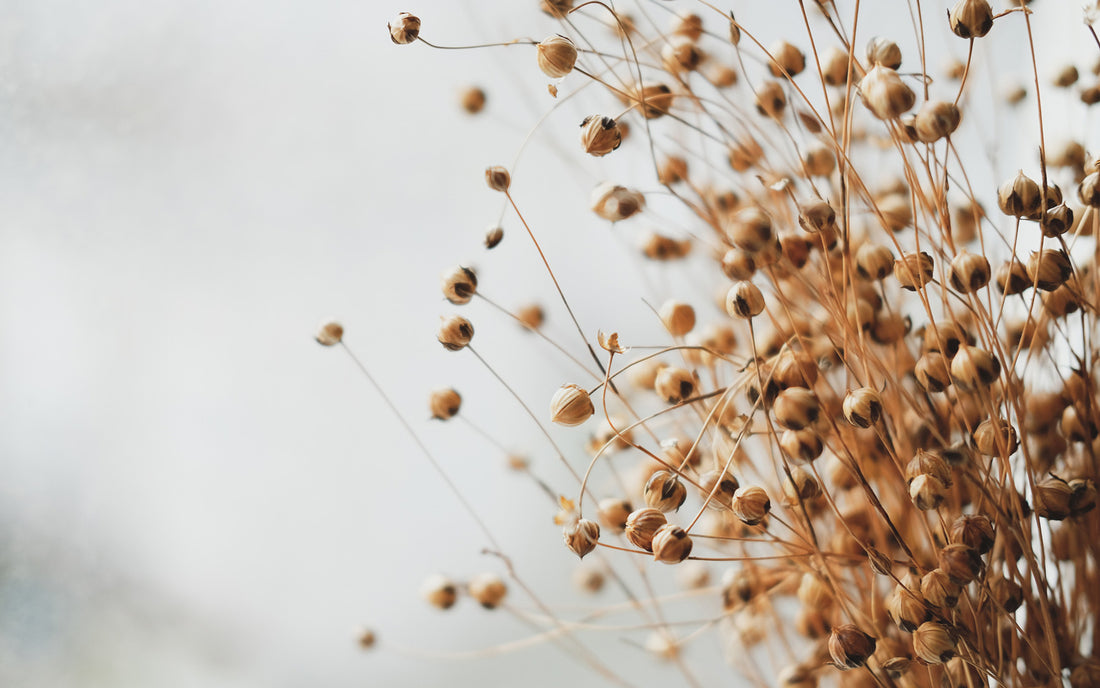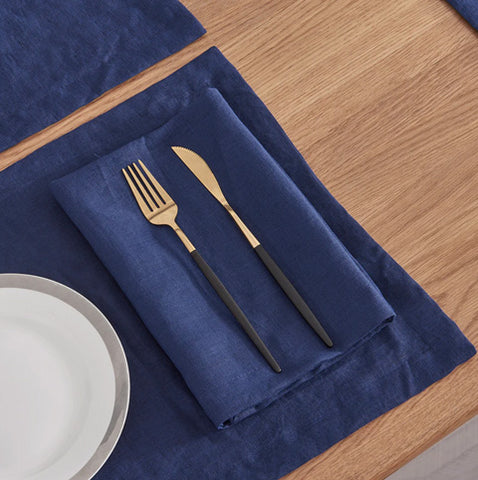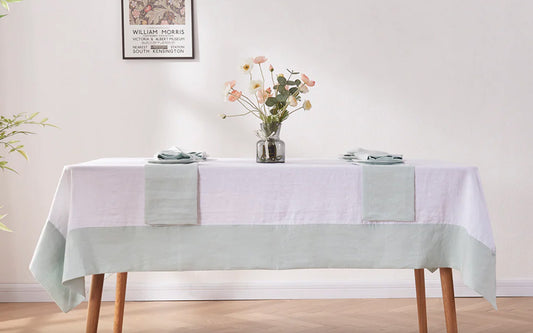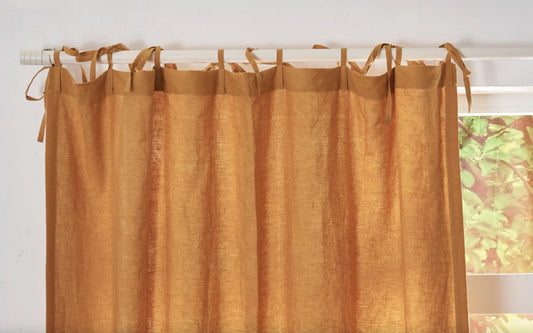We’ve been living with linen fabric longer than anyone can remember.
That’s genuinely true. Flax linen has been used to make cloth since at least 8,000 BC. As a matter of fact, fine linen fabrics were found inside ancient Egyptian tombs. To think, if it was good enough for a mummy, it’s definitely good enough for you!
Linen has never gone out of style. Today, linen is used to make clothes, bedding, table linens, and so much more. But how many of us really know what flax linen is, how it’s made, or why it’s perfect for our homes and so good for us to use?
What is Linen Fabric Made From?

Flax linen is a fabric made from the flax plant (Linum usitatissimum), a slender, leafy plant that produces beautiful blue flowers during the summer months. The harvested fibers of the flax plant come from the stem and are strong and durable, which makes them ideal for weaving into fabric.
Flax Plants and Sustainability
The flax plant grows in temperate climates (often in northern Europe) and offers many benefits, including its incredible quality because it’s so sustainable and easy to grow. Specifically, the hearty flax plant doesn’t require a lot of irrigation outside of natural rainfall and is resilient enough to require few pesticides or fertilizers. It can be grown organically—another bonus!
And flax linen isn’t the only good thing that comes from these plants. The stems are used for textiles, but the seeds are also harvested to make linseed oil, among other items.
How is Flax Linen Fabric Made?
With the exception of modernized machinery, the process of making flax linen yarn hasn’t changed much over the centuries. First, farmers harvest the flax plant about one month after it begins to flower—when the stalks have started to yellow.
Once the stalks are harvested from the fields, they go through a process known as retting. Retting uses a combination of bacteria and moisture to eventually separate the fibers from the stems of the stalks. The process occurs either by using nighttime dews (combined with warm daytime temperatures) or by submerging the bundles of flax stalks in water (the most common method).
After the stalks are retted, the inner fibers are removed through a process called scutching. During the scutching process, a machine separates the fibers from the stalks, leaving silky smooth flax threads. (A modern scutching machine can process over 1,000 pounds of flax and produce about 150 pounds of flax fibers every hour!)
The longest flax fibers are then set aside to make yarns for linen fabric. Flax yarns are known to be thick and strong—up to three times stronger than cotton—which means they can last for decades. That means that after spinning the fibers from the plant, the resulting product is lightweight, breathable, and luxurious linen fabric that can be made into a wide variety of products, like the perfect home décor.
Why is Flax Linen Perfect for My Home?
Flax linen is the perfect fabric for home décor. Its beauty and stylish elegance appeal to everyone. Linen fabric has a variety of uses and can complement any style. No matter the feel of your home—boho to classic, and anything in between—linen fits in well with any décor you choose. When your home looks good, you feel good.
Linen In the Bedroom
With flax linen bedding, you’ll find yourself in heaven—right in your own home! The gentle, natural texture of the linen fabric soothes your senses and provides a calming experience, so you’ll get high-quality sleep and be ready to take on the day with renewed energy. (Plus, if you or your partner sleeps hotter than a furnace, you’ll both stay super cool all night long.)
Linen In the Bathroom
Your most private moments deserve stylish design as well. Upgrade to linen shower curtains in your bathroom for a truly timeless and spa-like design that everyone in your home will appreciate. The antimicrobial and moisture-wicking properties of the fabric make it a great addition to a clean bathroom retreat.
Linen At Your Table
Your table linens will also be on point, thanks to easy-to-clean linen fabric tablecloths, table runners, placemats, and napkins. Go bold with color, or choose a muted, monochromatic scheme. (Or mix and match, of course!) No matter which colors you pick, your dinner guests will experience fine dining and function.
Linen Over the Windows
And don’t forget your windows! Linen fabric curtains dress up any space in your home, tying together a whole room with a burst of customized sophistication. With so many options available in different colors and lengths—and multiple options for light-filtering, from single-layer to blackout—every room of your home can achieve that airy aesthetic!
The Many Health Benefits of Flax Linen
Did you know linen fabric is actually good for you? Flax linen offers a multitude of health benefits beyond elevating the look and feel of your home. It’s a great fabric to promote wellness for every member of your family—from your pets to your kids to the oldest person in your house!
Our favorite health benefits of linen include:
- It’s antibacterial
- It's breathable
- It’s odor-resistant
- It’s super hygienic
- It’s moisture-wicking
Linen is a naturally antibacterial and hypoallergenic fabric, perfect for those whose pets snuggle in bed or anyone with chronic allergies. It’s also breathable and moisture-wicking, so you can snuggle up in your linen bedding and stay cozy all night long without sweating up a storm. And it’s odor-resistant, making it the perfect fabric to withstand the athletic kid’s bedroom or the messiness of well-seasoned meals.
How Do I Care for Flax Linen Fabric?
Given how it’s produced, flax linen is extremely sustainable and durable. It also gets softer with each use. However, there are a few important things to remember when caring for your linen fabric:
When Washing Linen:
- Spot clean or pre-treat for deep stains.
- Wash with other pieces of the same linen fabric or a similarly colored piece of laundry.
- Set the water temperature to a maximum of 30 C/86 F.
- Use a mild liquid detergent on the gentle cycle.
- Do not pour detergent directly onto linen.
- Do not bleach or use fabric softeners.
When Drying Linen:
- Dry at low heat on the delicate setting to preserve the lifespan of the linen fabric.
- Do not dry-clean.
- Do not iron on high heat.
- Do not overload the washer or dryer.
The Perfect Home Starts with Flax Linen
Even the ancient Egyptians could agree—nothing beats using a linen fabric to make a statement for your home and for your health. From snuggling up under the perfect linen duvet cover at night to dressing up your table with linens for a fancy dinner—or anything in between—we love using linen fabrics throughout our homes, and you will, too!





